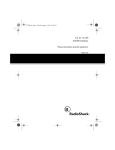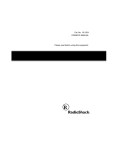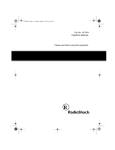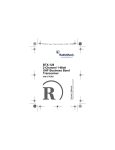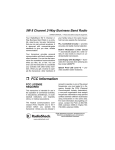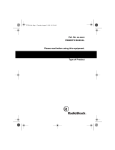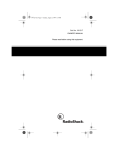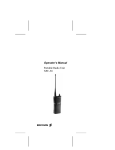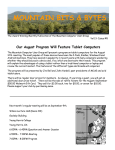Download Radio Shack BTX-124 Owner`s manual
Transcript
19-1205.fm Page 1 Tuesday, August 3, 1999 10:30 AM Cat. No. 19-1205 OWNER’S MANUAL Please read before using this equipment. BTX-124 VHF FM Business Band Transceiver with CTCSS 19-1205.fm Page 2 Tuesday, August 3, 1999 10:30 AM FEATURES Your RadioShack BTX-124 VHF FM Business Band Transceiver with CTCSS is a portable, two-way business radio service transceiver that you can carry almost anywhere. The transceiver is compact and light, making it an ideal choice for your business needs. High/Low Power — lets you save power by selecting a suitable transmitting power for long or short distances. Your transceiver has these features: Removable and Rechargeable Battery Pack — lets you use one battery pack while you charge another (additional packs available). Programmable Channels A and B — let you operate the transceiver on two different frequencies. Preset Frequencies — let you quickly begin operation on either 154.600 MHz (Channel A, green dot) or 154.570 MHz (Channel B, blue dot). PLL-Controlled Circuitry — provides accurate and stable channel selection. Adjustable Squelch — helps eliminate noise between transmissions. CTCSS (Continuous Tone Control Squelch System) — helps reduce interference from other systems in the area operating on the same frequency. Built-In Modulation Limiter Circuit — automatically adjusts for a wide variety of voice levels to ensure an understandable transmission. Battery Low and Transmit Indicator — shows the battery pack’s condition and lights when you transmit or receive. Supplied Battery Charger — conveniently recharges your transceiver’s battery pack. Earphone Jack and External Microphone Jack — let you use an earphone or external microphone to help ensure understandable communications in noisy areas. Belt Pouch — protects your transceiver and lets you easily carry it on your belt. We recommend you record your transceiver’s serial number here. The number is on the back of the transceiver. Serial Number___________________ © 1997 Tandy Corporation. All Rights Reserved. RadioShack is a registered trademark used by Tandy Corporation. 2 19-1205.fm Page 3 Tuesday, August 3, 1999 10:30 AM CONTENTS FCC Regulations ................................................................................................... 4 FCC License Required ..................................................................................... 4 FCC Part 90 Rules ........................................................................................... 4 Preparation ............................................................................................................ Charging the Battery Pack ............................................................................... Checking the Battery Power ...................................................................... Using the Belt Clip ........................................................................................... Using an Earphone .......................................................................................... Connecting an Antenna ................................................................................... Using an External Microphone ......................................................................... 6 6 7 7 7 8 8 Operation ............................................................................................................... 9 Why Use CTCSS? ......................................................................................... 10 Operational Hints ........................................................................................... 10 Additional FCC Regulations .............................................................................. 11 Maintenance ........................................................................................................ 12 Specifications ..................................................................................................... 13 3 19-1205.fm Page 4 Tuesday, August 3, 1999 10:30 AM FCC REGULATIONS FCC LICENSE REQUIRED The Federal Communications Commission (FCC) requires you to have a license before you operate this transceiver. Unless you qualify to operate on the supplied frequencies, you must apply for a frequency through the PCIA (Personal Communication Industry Association), a non-profit organization that assigns frequencies nationwide to help prevent conflicts between different businesses using transceivers in the same area. For more information about getting a license, contact the PCIA at 800-759-0300, extension 3068 (in Virginia 703-739-0300, extension 3068). For other questions concerning the license application, contact the FCC at 717-337-1212, or write: FCC PART 90 RULES You must be familiar with Part 90 of FCC Rules before you operate your transceiver. The operation instructions in this manual conform to Part 90, but do not cover all items in Part 90. • You must have a valid license before you use the transceiver. For the latest FCC application form and instructions, call the FCC’s fax-on-demand service from a fax machine at 1202-418-0177 and request one or more of the following documents: 4 This transceiver is intended for use in the operation of commercial activities, educational, philanthropic, or ecclesiastical institutions, and hospitals, clinics, or medical associations. Overall, Part 90 states that: FCC P.O. Box 1040 Gettysburg, PA 17325 All forms and instructions Form 600 instructions only Main Form 600 only Form 600 schedules only If you do not have a fax machine, you can call the Government Forms Distribution Center at 1-800-418-FORM and request that the form and instructions be mailed to you. 000600 006001 006002 006003 • As licensee, you are responsible for proper operation of all transceivers operating under your license authority. • You can let unlicensed persons operate this transmitter, as long as you take precautions to prevent unauthorized transmissions. 19-1205.fm Page 5 Tuesday, August 3, 1999 10:30 AM • You must use this transceiver only for the commercial use of your business, and only when other commercial channels (such as the telephone) are either not available or not practical. • You must always yield the operating frequency to communications that involve the safety of life or property. • You must take reasonable precautions to prevent harmful interference to other services operating on the same frequency. • You must not transmit program material of any kind used in connection with commercial broadcasting. • You must not provide a service that is normally handled by telephone or telegraph unless such broadcasts involve the safety of life or property or in emergencies such as an earthquake, hurricane, flood or a similar disaster where normal communication channels are disrupted. • You must keep a written record of any maintenance or modification made to the transceiver, and you must make this record available for inspection upon demand by the FCC. Violating any of the provisions of Part 90 can result in fines and/or confiscation of equipment. Your transceiver might cause TV or radio interference even when it is operating properly. To determine whether your transceiver is causing the interference, turn off your transceiver. If the interference goes away, your transceiver is causing it. Try to eliminate the interference by: • Moving your transceiver away from the receiver • Contacting your local RadioShack store for help • During each transmission or exchange of transmissions, you must identify your station with the call sign issued to you by the FCC, or once each 15 minutes during periods of continuous operation. 5 19-1205.fm Page 6 Tuesday, August 3, 1999 10:30 AM PREPARATION Before you use the transceiver, you must be properly licensed by the FCC. If you are licensed to use one or both of the supplied frequencies, you can immediately use the transceiver. If you are licensed on different frequencies, your local RadioShack store must send the transceiver to an authorized service facility to have the frequencies programmed into the transceiver. You must tell the store the frequency you are licensed for and any desired CTCSS tone (the factory preset is 100.0 Hz). See “Why Use CTCSS?” on Page 11 for more information about CTCSS. CHARGING THE BATTERY PACK You must charge the battery pack with the supplied battery charger before you use it the first time, and whenever the battery becomes low. You can charge the battery pack with it attached to the transceiver or removed. To attach the battery pack, slide it onto the transceiver. To remove the battery pack, press down and slide RELEASE in the direction of the arrow, then slide off the pack. 6 ILLUSTRATION Follow these steps to charge the battery pack. 1. If the transceiver is on, turn VOL counterclockwise until it clicks to turn it off. ILLUSTRATION 2. Plug the charger’s barrel plug into the CHRG jack on the side of the 19-1205.fm Page 7 Tuesday, August 3, 1999 10:30 AM battery pack, then connect the charger to a standard AC outlet. ILLUSTRATION 7 19-1205.fm Page 8 Tuesday, August 3, 1999 10:30 AM Note: Charging time is 14 to 16 hours. Cautions: • To prevent permanent battery power loss, never charge the batteries in an area where the temperature is above about 80°F. The charger does not operate at all at temperatures below 32°F or above 113°F. • Never use any other charger to recharge the transceiver’s battery pack. This could permanently damage your transceiver or the battery pack. Important: This transceiver uses a rechargeable nickel-cadmium battery pack. At the end of the battery pack’s useful life, it must be recycled or disposed of properly. Contact your local, county, or state hazardous waste management authorities for information on recycling or disposal programs in your area. Some options that might be available are: municipal curbside collection, drop-off boxes at retailers such as your local RadioShack store, recycling collection centers, and mail-back programs. Checking the Battery Power 1. Rotate VOL clockwise until it clicks to turn on the transceiver. 8 2. Press the push-to-talk button on the left side of the transceiver. If BUSY•TX/LO BATT lights red, there is sufficient battery power for transmission. If the indicator lights yellow, you need to recharge the battery pack. ILLUSTRATION Using the Belt Clip The supplied belt clip lets you easily clip the transceiver to your belt. Use a small Phillips screwdriver to secure the clip to the transceiver’s back with the supplied screws and washers, then attach it to your belt. Using an Earphone To listen privately or to hear better in a noisy area, you can plug a monaural earphone into the EAR jack on the top of the transceiver. This automatically disconnects the speaker. 19-1205.fm Page 9 Tuesday, August 3, 1999 10:30 AM CONNECTING AN ANTENNA Attach the flexible antenna to the antenna jack on top of the transceiver. Place the antenna connector’s slots over the antenna jack’s tabs, squeeze the base of the antenna, and push down and turn the connector until the antenna locks into place. ILLUSTRATION Instead of the supplied antenna, you can connect an optional antenna. The BNC antenna jack on your transceiver makes it easy to use with a variety of antennas, such as an external mobile antenna or an outdoor base antenna. Warning: When installing or removing a base station antenna, use extreme caution. If it starts to fall, let it go! It could contact overhead power lines. If the antenna touches the power line, contact with the antenna, mast, cable, or guy wires can cause electrocution and death! Call the power company to remove the antenna. Do not attempt to do so yourself. USING AN EXTERNAL MICROPHONE An external microphone can make it easier to use the transceiver when you clip it to your belt. Plug the microphone’s cable connector into the MIC jack on top of the transceiver. This automatically disconnects the transceiver’s microphone. Note: The transceiver’s push-to-talk button still works with an external microphone attached. Caution: Never connect an antenna that is not specifically tuned for the transceiver’s frequency range. 9 19-1205.fm Page 10 Tuesday, August 3, 1999 10:30 AM OPERATION 1. Turn VOL clockwise to turn on the transceiver. ILLUSTRATION 2. Select Channel A or B using the CHANNEL switch on the top of the transceiver. ILLUSTRATION 3. To conserve battery power, set POWER to LO. If the person you transmit to has trouble receiving your signal, set POWER to HI. ILLUSTRATION 10 4. To transmit, hold down push-to-talk, then hold your transceiver about 3 inches from your mouth and speak slowly in a normal tone of voice. The BUSY•TX/LO BATT indicator lights red. 5. When you finish your message, release push-to-talk. The BUSY•TX/ LO BATT indicator lights green when you receive a transmission. 6. Adjust VOL to a comfortable listening level. 7. If you are not using CTCSS, wait until there is no signal on the channel, then slowly turn SQL/CTCSS clockwise until the background noise stops. Note: Do not turn SQL/CTCSS too far clockwise because you might cut out weak signals. If you are using CTCSS (see “Why Use CTCSS?” on Page 11), turn SQL/CTCSS counterclockwise until it clicks. 8. To turn off the transceiver, turn VOL counterclockwise. 19-1205.fm Page 11 Tuesday, August 3, 1999 10:30 AM WHY USE CTCSS? OPERATIONAL HINTS CTCSS (Continuous Tone-Coded Squelch System) helps eliminate interference between different users of the same frequency. When CTCSS is turned on, the transceiver transmits a selected tone with your transmission. This tone is too low for you to hear, but other transceivers can detect it. If CTCSS is turned on and set to the same tone on the receiving transceiver, it only receives those transmissions that include the tone. Your transceiver’s range varies depending on factors such as position, terrain, and battery condition. Buildings absorb transmitted signals and, if they contain metal, might completely block the signals. Trees and heavy cloud formations have a similar effect, though not as severe. If you are near a lake or the ocean, you might get excellent range. If two different groups operate transceivers in the same area on the same frequency, they do not hear each other’s broadcasts if they both use CTCSS and each select a different CTCSS tone. To ensure maximum range, operate the transceiver with the battery pack fully charged. As the voltage decreases, the range decreases. There are 38 different CTCSS tones available. The CTCSS tone default for this unit is 100 Hz. See “Available CTCSS Tones” on Page 15 for a complete list. Only authorized RadioShack Service Centers can change the CTCSS tone. 11 19-1205.fm Page 12 Tuesday, August 3, 1999 10:30 AM ADDITIONAL FCC REGULATIONS The Business Radio Service is under the jurisdiction of the Federal Communications Commission (FCC). Any adjustments or alterations that would alter the performance of the transceiver so it no longer meets the original FCC type acceptance or would change the frequency-determining method are strictly prohibited. Replacement or substitution of crystals, transistors, ICS, regulator diodes, or any other component that is of a unique nature with components other than those recommended can violate the technical regulations of the FCC rules or violate type acceptance requirement of the rules. Before you operate the transceiver, you must obtain your license. It is illegal to transmit without the appropriate license, which you can get by submitting a completed FCC Form 600 to the FCC (or through the PCIA if you do not qualify for either of the supplied frequencies). Furthermore, you are required to understand Part 90 of the FCC Rules and Regulations prior to operating your transceiver. It is the user’s responsibility to see that this unit is operating at all times in accordance with the FCC Rules and Regulations. 12 19-1205.fm Page 13 Tuesday, August 3, 1999 10:30 AM MAINTENANCE Your RadioShack BTX-124 VHF FM Business Band Transceiver with CTCSS is an example of superior design and craftsmanship. The following suggestions will help you care for your transceiver so you can enjoy it for years. Keep the transceiver dry. If it gets wet, wipe it dry immediately. Liquids might contain minerals that can corrode the electronic circuits. Use and store the transceiver only in normal temperature environments. Temperature extremes can shorten the life of electronic devices, damage batteries, and distort or melt plastic parts. Keep the transceiver away from dust and dirt, which can cause premature wear of parts. Handle the transceiver gently and carefully. Dropping it can damage circuit boards and cases and can cause the transceiver to work improperly. Use only fresh batteries of the required size and type. Batteries can leak chemicals that damage your transceiver’s electronic parts. Wipe the transceiver with a damp cloth occasionally to keep it looking new. Do not use harsh chemicals, cleaning solvents, or strong detergents to clean the transceiver. Modifying or tampering with the transceiver’s internal components can cause a malfunction and might invalidate your transceiver’s warranty and void your FCC authorization to operate it. If your transceiver is not performing as it should, take it to your local RadioShack store for assistance. 13 19-1205.fm Page 14 Tuesday, August 3, 1999 10:30 AM SPECIFICATIONS Transmitter Frequency Coverage ........................................................ 150.775 to 155.985 MHz Frequency Tolerance .................................................................................. ±1.5 kHz Modulation Type ................................................................................................... FM Modulation Distortion ........................................................................................... 9% CTCSS Tone Deviation ............................................................................... ±0.8 kHz Maximum Deviation ....................................................................................... ±5 kHz Minimum Operating Voltage ........................................................................... 7 Volts RF High Power Output (8.4 V) ..................................................... 2 Watts ±0.2 Watt RF Low Power Output ............................................................... 0.6 Watts ±0.2 Watt Current Drain at High Power ........................................................................ 700 mA Current Drain at Low Power ......................................................................... 450 mA Receiver Frequency Range ............................................................. 150.775 to 155.985 MHz Auto Output Power at 10% THD ................................................................ 0.25 Watt Signal-to-Noise Ratio (20 dB) ...................................................................... 0.75 µV Working Voltage .......................................................................................... 8.4 Volts Adjacent Channel Rejection ............................................................................ 45 dB Audio Distortion .................................................................................................... 5% Squelch Sensitivity (Start) .............................................................................. 0.5 µV Distortion (1 mV Input 4.3 kHz) ............................................................................ 5% Current Drain at Maximum Power ................................................................ 200 mA Current Drain at Standby ............................................................................... 60 mA 14 19-1205.fm Page 15 Tuesday, August 3, 1999 10:30 AM Factory Defaults CTCSS Tone 100 Hz Channel A 154.600 MHz Available CTCSS Tones Channel B 154.570 MHz Frequency (Hz) 67.0 97.4 136.5 192.8 71.9 100.0 141.3 203.5 74.4 103.5 146.2 210.7 77.0 107.2 151.4 218.1 79.7 110.9 156.7 225.7 82.5 114.8 162.2 233.6 85.4 118.8 167.9 241.8 88.5 123.0 173.8 250.3 91.5 127.3 179.9 94.8 131.8 186.2 General Power Supply 8.4 Volts DC Antenna Length 163 mm Dimensions (HWD) 21/2 × 11/2 × 6 Inches (65 × 35 × 160 mm) Weight 14.66 oz (416 g) Specifications are typical; individual units might vary. Specifications are subject to change and improvement without notice. 15 19-1205.fm Page 16 Tuesday, August 3, 1999 10:30 AM NOTES Limited One-Year Warranty This product is warranted by RadioShack against manufacturing defects in material and workmanship under normal use for one (1) year from the date of purchase from RadioShack company-owned stores and authorized RadioShack franchisees and dealers. EXCEPT AS PROVIDED HEREIN, RadioShack MAKES NO EXPRESS WARRANTIES AND ANY IMPLIED WARRANTIES, INCLUDING THOSE OF MERCHANTABILITY AND FITNESS FOR A PARTICULAR PURPOSE, ARE LIMITED IN DURATION TO THE DURATION OF THE WRITTEN LIMITED WARRANTIES CONTAINED HEREIN. EXCEPT AS PROVIDED HEREIN, RadioShack SHALL HAVE NO LIABILITY OR RESPONSIBILITY TO CUSTOMER OR ANY OTHER PERSON OR ENTITY WITH RESPECT TO ANY LIABILITY, LOSS OR DAMAGE CAUSED DIRECTLY OR INDIRECTLY BY USE OR PERFORMANCE OF THE PRODUCT OR ARISING OUT OF ANY BREACH OF THIS WARRANTY, INCLUDING, BUT NOT LIMITED TO, ANY DAMAGES RESULTING FROM INCONVENIENCE, LOSS OF TIME, DATA, PROPERTY, REVENUE, OR PROFIT OR ANY INDIRECT, SPECIAL, INCIDENTAL, OR CONSEQUENTIAL DAMAGES, EVEN IF RadioShack HAS BEEN ADVISED OF THE POSSIBILITY OF SUCH DAMAGES. Some states do not allow the limitations on how long an implied warranty lasts or the exclusion of incidental or consequential damages, so the above limitations or exclusions may not apply to you. In the event of a product defect during the warranty period, take the product and the RadioShack sales receipt as proof of purchase date to any RadioShack store. RadioShack will, at its option, unless otherwise provided by law: (a) correct the defect by product repair without charge for parts and labor; (b) replace the product with one of the same or similar design; or (c) refund the purchase price. All replaced parts and products, and products on which a refund is made, become the property of RadioShack. New or reconditioned parts and products may be used in the performance of warranty service. Repaired or replaced parts and products are warranted for the remainder of the original warranty period. You will be charged for repair or replacement of the product made after the expiration of the warranty period. This warranty does not cover: (a) damage or failure caused by or attributable to acts of God, abuse, accident, misuse, improper or abnormal usage, failure to follow instructions, improper installation or maintenance, alteration, lightning or other incidence of excess voltage or current; (b) any repairs other than those provided by a RadioShack Authorized Service Facility; (c) consumables such as fuses or batteries; (d) cosmetic damage; (e) transportation, shipping or insurance costs; or (f) costs of product removal, installation, set-up service adjustment or reinstallation. This warranty gives you specific legal rights, and you may also have other rights which vary from state to state. RadioShack Customer Relations, Dept. W, 100 Throckmorton St., Suite 600, Fort Worth, TX 76102 We Service What We Sell 3/97 RadioShack A Division of Tandy Corporation Fort Worth, Texas 76102 5A7 Printed in Hong Kong
















